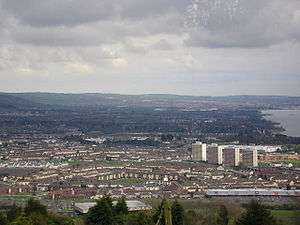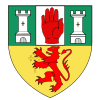Newtownabbey
| Newtownabbey | |
| Irish: Baile Nua na Mainistreach[1] | |
 Overlooking the Rathcoole area of Newtownabbey from Cavehill |
|
 |
|
| Population | 62,056 (2001 Census) |
|---|---|
| District | Antrim and Newtownabbey |
| County | County Antrim |
| Country | Northern Ireland |
| Sovereign state | United Kingdom |
| Post town | NEWTOWNABBEY |
| Postcode district | BT36, BT37 |
| Dialling code | 028 |
| Police | Northern Ireland |
| Fire | Northern Ireland |
| Ambulance | Northern Ireland |
| EU Parliament | Northern Ireland |
| NI Assembly | East Antrim |
|
|
Coordinates: 54°39′25″N 5°54′25″W / 54.657°N 5.907°W
Newtownabbey is a major urban area on the outskirts of north Belfast it is separated from the city by the M2 motorway. At the 2001 Census, Newtownabbey Urban Area had a population of 62,056, making it the fourth largest settlement in Northern Ireland. It is part of Antrim and Newtownabbey Borough Council.
Largely a residential area, the borough is also home to many engineering and computer industries. Retail and leisure facilities include the Abbey Centre, the Valley Leisure Centre, the Ballyearl Arts & Leisure Centre,The Theatre at the Mill, Glengormley Moviehouse, Glengormley Sportsbowl and three large public parks. The main campus for the University of Ulster is based in the Jordanstown area of Newtownabbey. Although the Jordanstown campus of the University of Ulster is due to merge with the current Belfast campus which is due to be completed by 2018.
History
Newtownabbey was formed by the merging of seven villages; Carnmoney, Glengormley, Jordanstown, Monkstown, Whiteabbey, Whitehouse and Whitewell. It was formally brought into being on 1 April 1958. Before its inception the expanse fell under the jurisdiction of the Belfast Rural District Council.
The timeline of the local government authority is: Newtownabbey Urban District Council (1958–1973), Newtownabbey District Council (1973–1977), Newtownabbey Borough Council (1977–2015) and Antrim & Newtownabbey District Council (2015– ).
By the spring of 2015 Newtownabbey Borough Council will be officially merged with adjacent Antrim Council to form the new Antrim & Newtownabbey District Council under Local Government restructuring plans devised by the Northern Ireland Executive. This name is still to be confirmed.
The Troubles
For more information see The Troubles in Newtownabbey, which includes a list of incidents in Newtownabbey during The Troubles resulting in two or more deaths.
Geography

Townlands
Below is a list of townlands that are within Newtownabbey's urban area, alongside their likely etymologies.
- Ballybought (from Irish: Baile Bocht, meaning "poor town")*
- Ballyduff (historically Ballymacelduffe; from Baile Mhic Giolla Dhuibh meaning "MacElduff's townland")*
- Ballygolan (historically Ballingowlan; from Baile an Ghabhláin or Baile Gobhláin meaning "townland of the fork")*
- Ballyhenry (from Baile Éinrí meaning "Henry's townland")*
- Ballyvesey (from Baile Feasoighe meaning "Vesey's townland")*
- Ballywonard (from Baile Mhuine Ard meaning "townland of the high thicket")*
- Carnmoney (from Carn Monaidh meaning "cairn of the bog")*
- Collinward (from Coll an Bháird meaning "the bard's hazel")*
- Cloughfern (historically Ballycurraghfarny; from Cruach Fearna meaning "stack of the alder" or Currach Fearnaí meaning "marsh of the place of alders")*
- Drumnadrough (from Druimainn Dorcha meaning "dark ridge" or Druim na gCruach meaning "ridge of the stacks"), where Merville Garden Village is located
- Dunanney (from Dún Aine meaning "Aine's stronghold")*
- Glengormley (from Gleann Ghormlaithe meaning "blue-grey valley")*
- Jordanstown (historically Ballyjordan and Ballyjurdan)
- Mallusk or Molusk (historically Moyvluske and Moyvliske; from Maigh Bhloisce meaning "Bloisce's plain")*
- Monkstown (historically Ballynamanagh; from Baile na Manach meaning "townland of the monks")
- Whiteabbey
- White House
* citation for derivations[2]
The following housing estates have Irish-derived names, although they are not named after townlands:[3]
- Mossley (O.E. mos meaning "peat-bog" + O.E. leah meaning "clearing", gaelicized as Maslaí)
- Rathcoole (likely from Ráth Cúile meaning "nook of the ringfort")
Electoral areas and wards
Until 2014 Newtownabbey operated under its own council comprising Ballyclare, Glengorley, Jordanstown, Carnmoney, Mallusk and Rathcoole. However, from 2014 it has operated as a larger Council after merging with Antrim to create Antrim and Newtownabbey Borough Council. The current electoral ward and areas are:
- Airport (1 DUP, 1 SDLP, 1 Sinn Féin, 2 UUP)
(Aldergrove, Clady, Crumlin, Mallusk, and Templepatrick)
- Antrim (1 Alliance, 2 DUP, 2 UUP, 1 SDLP)
(Antrim Centre, Fountain Hill, Greystone, Springfarm, Steeple, and Stiles)
- Ballyclare (3 DUP, 2 UUP, 1 TUV)
(Ballyclare East, Ballyclare West, Ballynure, Ballyrobert, and Doagh)
- Dunsilly (2 DUP, 1 UUP, 1 SDLP 1 Sinn Féin)
(Cranfield, Parkgate, Randalstown, Shilvodan, and Toome)
- Glengormley Urban (1 Alliance, 3 DUP, 2 UUP, 1 Sinn Féin)
(Ballyhenry, Burnthill, Carnmoney, Collinbridge, Glebe, Glengormley, and Hightown)
- Macedon (1 Alliance, 4 DUP, 1 UUP)
(Abbey, Carnmoney Hill, O'Neill, Rathcoole, Valley, and Whitehouse)
- Three Mile Water (1 Alliance, 3 DUP, 2 UUP)
(Ballyduff, Fairview, Jordanstown, Monkstown, Mossley, and Rostulla)
Demography
Newtownabbey Urban Area is classified as a large town (i.e. with population between 18,000 and 75,000 people in the 2001 census) by the Northern Ireland Statistics and Research Agency (NISRA)[4] and is within the Belfast Metropolitan Urban Area (BMUA). On Census day (27 March 2011) there were 85,139 people living in Newtownabbey. Of these:
- 20.4% were aged under 16 years and 15.4% were aged 65 and over
- 48.2% of the population were male and 51.8% were female
- 22.56% were from a Catholic background and 67.76% were from a Protestant background.
- 3.8% of people aged 16–74 were unemployed.
Education
- Higher-level education
- University of Ulster at Jordanstown (UUJ)
- Northern Regional College (NRC)
- Secondary-level education
- Ballyclare High School
- Belfast High School
- Edmund Rice College
- Glengormley High School
- Monkstown Community School
- Newtownabbey Community High School
- Primary-level education
- Jordanstown Schools for the Deaf and Blind
- Whitehouse Primary School
Sport
- Cricket
- Academy Cricket Club
- Cliftonville Cricket Club
- Football
- 18th Newtownabbey Old Boys F.C.
- FC Whiteabbey
- Mossley Young Men F.C.
- Nortel F.C.
- Rathfern Rangers F.C.
- U.U.J. F.C.
- Gaelic games
- Hockey
- East Antrim Hockey Club
- Mossley Hockey Club
- Owls Hockey Club
- Rugby
- Academy Rugby Club
- Ballyclare Rugby Club
- Belfast High School Former Pupils Rugby Club
- Ophir Rugby Club
Churches
- Abbey Presbyterian Church
- Abbots Cross Congregational Church
- Ballycraigy Congregational Church
- Ballyhenry Presbyterian Church
- The Church of the Good Shepherd (United Church of Ireland and Methodist)
- Church of the Holy Spirit (Church of Ireland) Mossley
- Church of the Holy Evangelists (Church of Ireland) Carnmoney
- Monkstown Baptist Church
- Newtownabbey Free Presbyterian Church
- Saint James's Catholic Church
- St Mary's on the Hill Parish Church
- St Bernard's Church
- St Brigid's Parish of Mallusk
- St Mac Nissi's Church
- St. Patrick's Church (Church of Ireland)
- Straid Congregational Church
- The Church of Jesus Christ of Latter-day Saints
- Trinity Reformed Presbyterian Church
- Whiteabbey Congregational Church
- Whiteabbey Methodist Church
- Whiteabbey Presbyterian Church
- Whitehouse Presbyterian Church
Transport
Trains
Northern Ireland Railways runs trains serving three railway stations: Mossley West railway station on the Belfast–Derry railway line and Jordanstown railway station and Whiteabbey railway station on the Belfast–Larne railway line.
Connecting trains run on the Belfast-Derry railway line from Mossley West, "Northbound" to: Antrim, Ballymena, Ballymoney, Coleraine (for the branch to University (Coleraine), Dhu Varren and Portrush), Castlerock, Bellarena, Londonderry. And "Southbound" to Yorkgate, Belfast Central (change for Belfast-Bangor railway line and the Enterprise), Botanic, City Hospital, Belfast Great Victoria Street and onwards.
Whilst the Belfast-Larne railway line serving Whiteabbey and Jordanstown and connects with other stations including the principal stations of Carrickfergus, Whitehead, Larne Town and Larne Harbour, heading "Northbound". And heading "Southbound" the same stations as listed above apply.
Buses
Bus services are provided by Metro.
Roads
Newtownabbey is linked to the M2 motorway (which passes through it) and the M5 motorway (which begins at its southeastern edge).
Twin towns
Newtownabbey is twinned with:
Newtownabbey has one sister city, as designated by Sister Cities International:
-
 Gilbert, Arizona, United States
Gilbert, Arizona, United States
References
- ↑ "Baile na Mainistreach/Newtownabbey". logainm.ie.
- ↑ "Northern Ireland Placenames Project". Retrieved 12 June 2010.
- ↑ "logainm.ie". logainm.ie.
- ↑ "NISRA - Northern Ireland Statistics and Research Agency (c) 2015". nisra.gov.uk.
- ↑ "Rybnik Official Website – Twin Towns". 2008 Urząd Miasta Rybnika. Retrieved 1 November 2008.
- ↑ "List of Twin Towns in the Ruhr District" (PDF). 2009 Twins2010.com. Retrieved 28 October 2009. External link in
|publisher=(help)
External links
| Wikimedia Commons has media related to Newtownabbey. |
- Culture Northern ireland
- Newtownabbey Today website of the Newtownabbey Times Newspaper
- Newtownabbey In Touch website of the Newtownabbey In Touch Magazine

